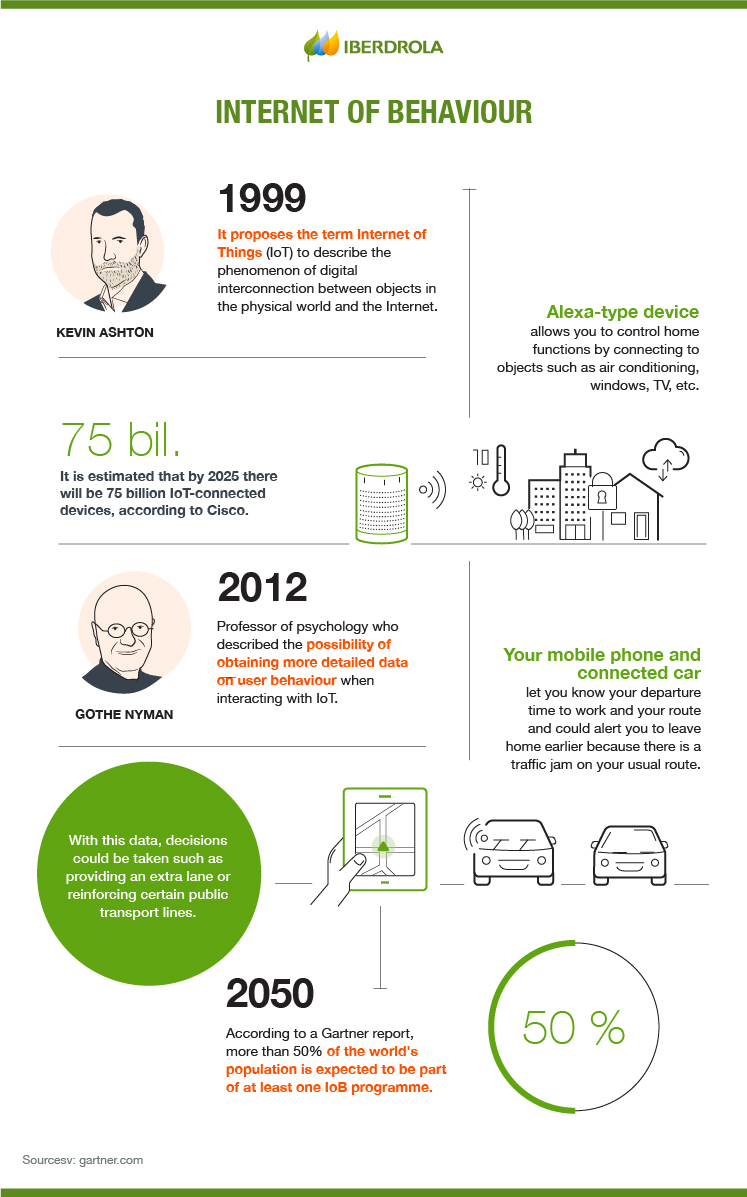INTERNET OF BEHAVIOUR
What is the Internet of Behaviour?
With the turn of the millennium came a new concept that referred to the digital interconnection between objects in the physical world and the Internet. It was the so-called Internet of Things (IoT) and, according to estimates by the US company Cisco, by 2025 there will be 75 trillion connected devices. As a result, the capacity for data collection multiplies and makes it possible, if analysed correctly, to obtain individual patterns on a massive scale. This is the Internet of Behaviour (IoB).

The advent of the so-called Internet of Behaviour (IoB) is actually almost a logical consequence of the birth of the Internet of Things. When Internet connectivity came to televisions and watches, giving rise to smart TVs and fitness wristbands, data and information began to be collected from those who used these devices. For example, to recommend other series or films similar to their tastes or with small alarms when they spent too much time sitting down.
This concept began to spread to give rise to what has come to be called the Internet of Everything (IoE) in which any entity establishes connections that open up new possibilities with related information. An example would be the so-called smart farms in which, by means of sensors, humidity, temperature, light or noise levels are measured and established and, in the same way, the state of the animals is reported through their heart rate or body temperature.
Faced with this enormous amount of data, the Internet of Behaviour (IoB) was born, which makes it possible to extract individual patterns that are multiplied on a massive scale. It was psychology professor Gothe Nyman who, in 2012, described the possibility of obtaining data on people's behaviour when interacting with the Internet of Things and how important it is not only to have the data but also to be able to interpret and understand it.
A very simple example would be a nutrition app that includes the food we eat and which, in turn, is synchronised with an activity bracelet that measures our physical activity, sleep and hydration. Each one obtains a good amount of data which, compiled and analysed, gives rise to a series of recommendations on food, exercise or habits which, in essence, are promoting a change in behaviour.
The Internet of Behaviour is therefore a combination of three fields:
Existing technology.
Analysis of the data generated.
Behavioral psychology to understand them.

SEE INFOGRAPHIC: From the Internet of Things to the Behavioural Internet [PDF]
ADVANTAGES AND CHALLENGES OF THE INTERNET OF BEHAVIOUR
Already in the "Top strategic predictions for 2020 and beyond" by the consulting firm Gartner, there was a mention of the IoB and the hyper-personalisation that this concept would bring about due to the continuous collection of data. In this way it is possible to detect and analyse the emotions of consumers and use this knowledge to influence people. As quoted in the same report: "By 2023, the behavioural Internet will digitally track individual activities to influence eligibility for benefits and services for 40% of people worldwide".
This knowledge obtained from data analysis translates into multiple benefits, especially for companies that can create an improved user experience or a personalisation of the offers that are shown to us, thus optimising the relationship with the consumer and doing so in real time. The Internet of Behaviour therefore becomes a proactive technology as it not only analyses behaviour but also detects the variables that influence it in order to bring about a specific result.
However, this raises an important ethical debate affecting the privacy of this data and the use made of it, as this flood of information is difficult to control, posing a major challenge for businesses. In addition, cybercrime may find sensitive data or data that reveal patterns of behaviour that facilitate increasingly advanced fraud. It is therefore important to strike a balance between personalisation and the intrusiveness that IoB can cause.




